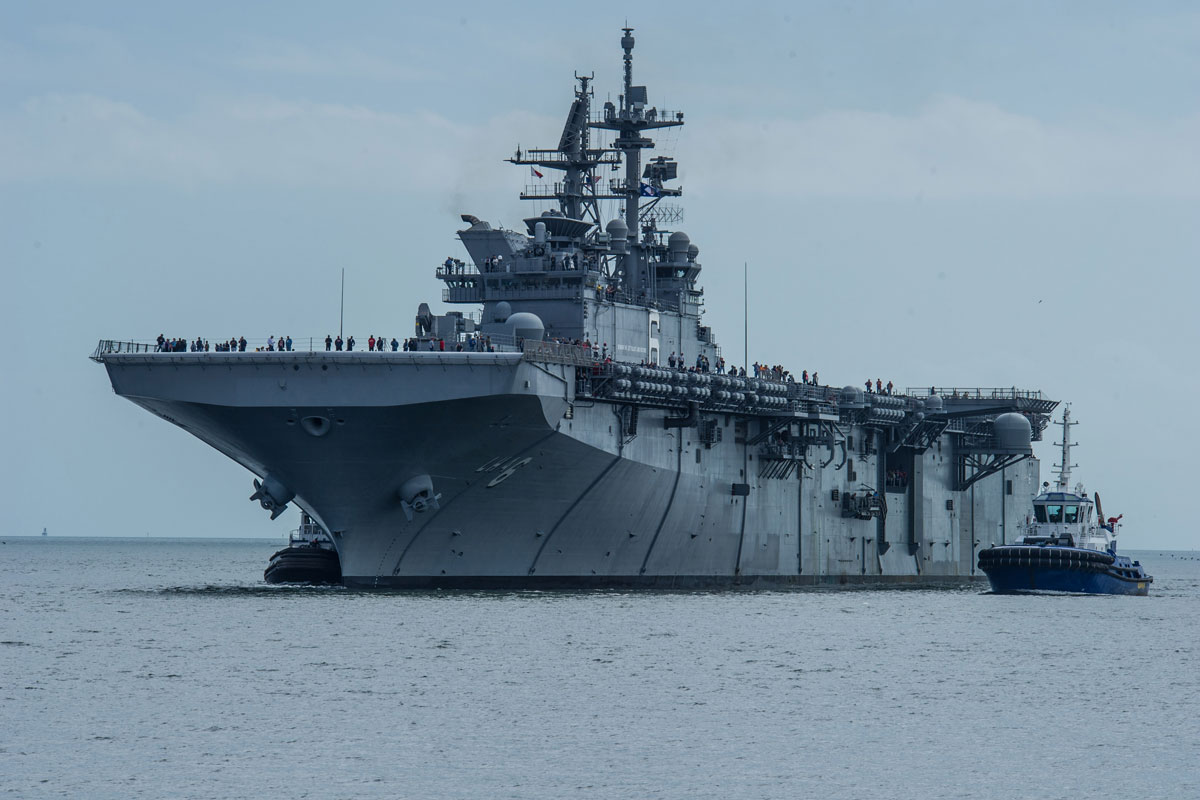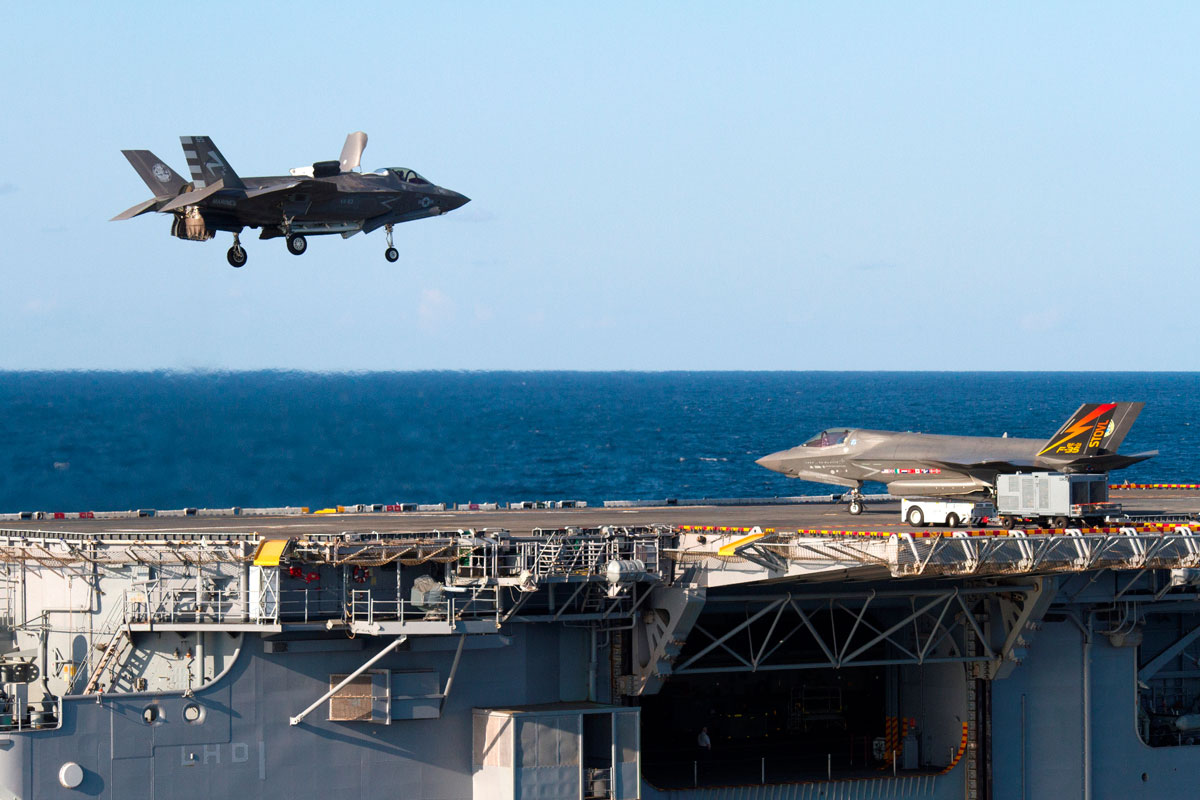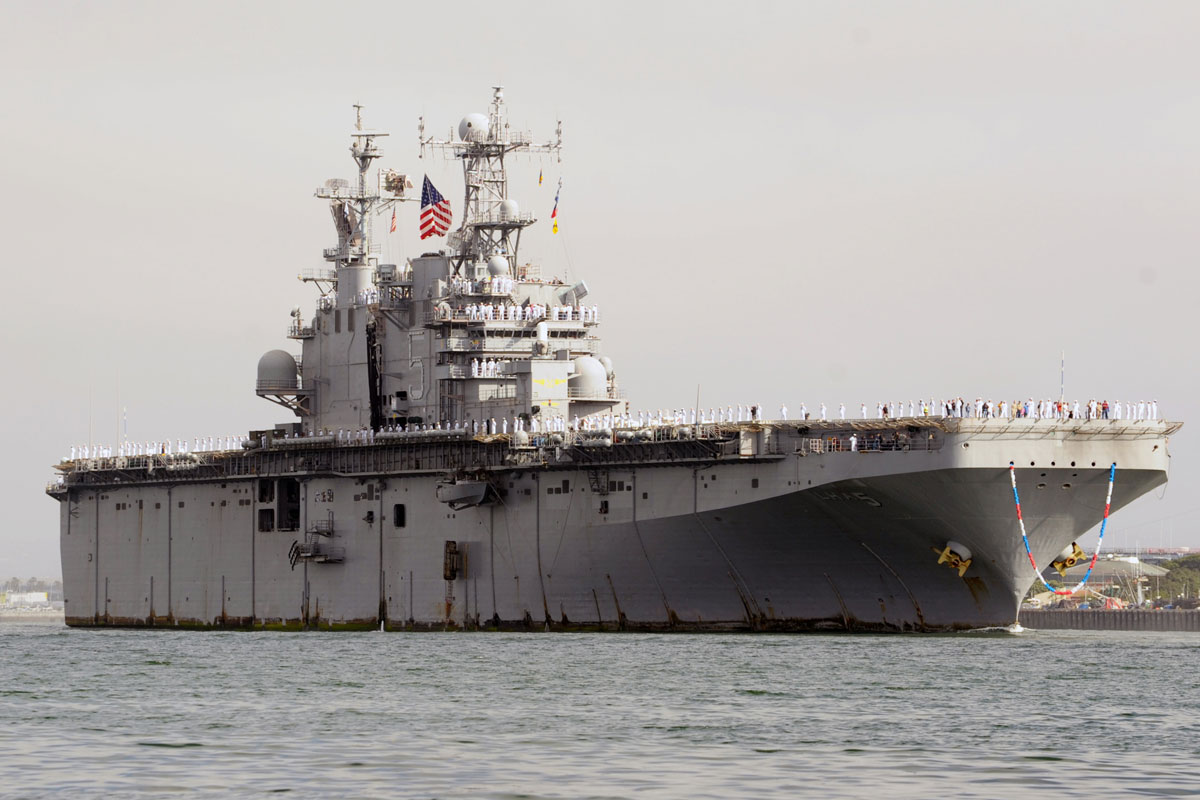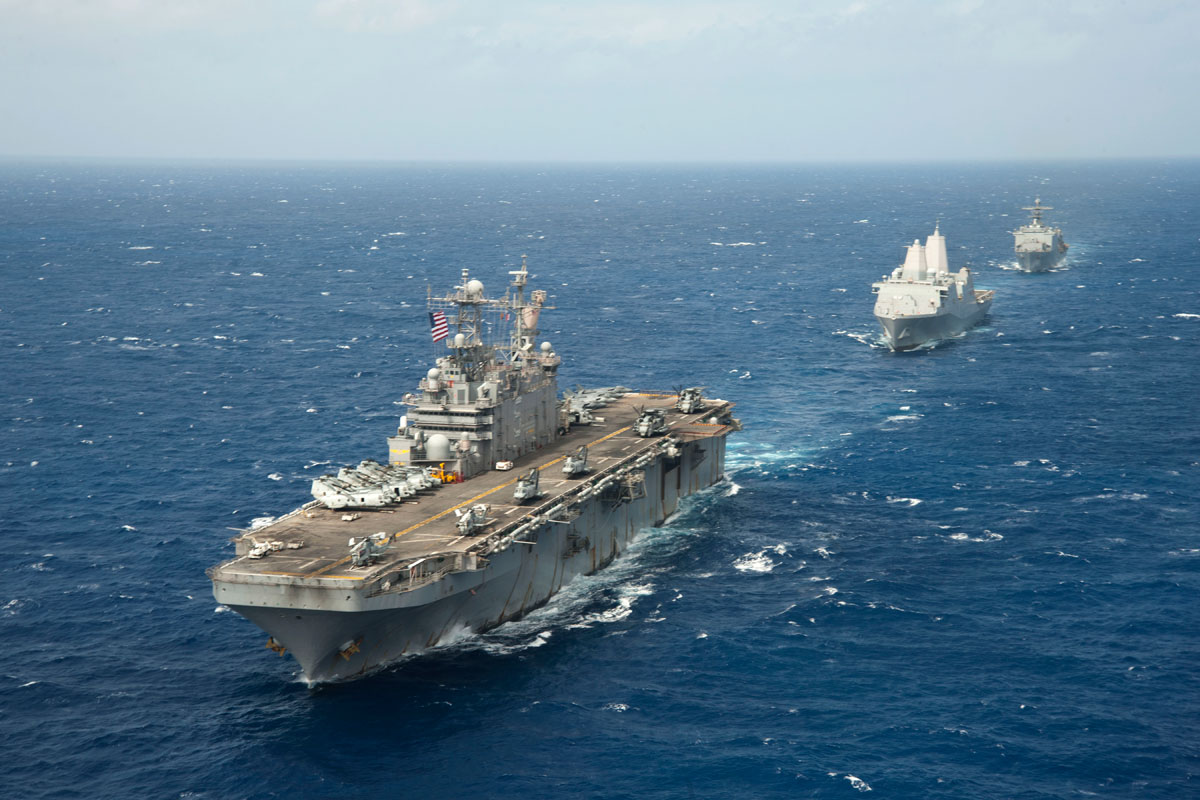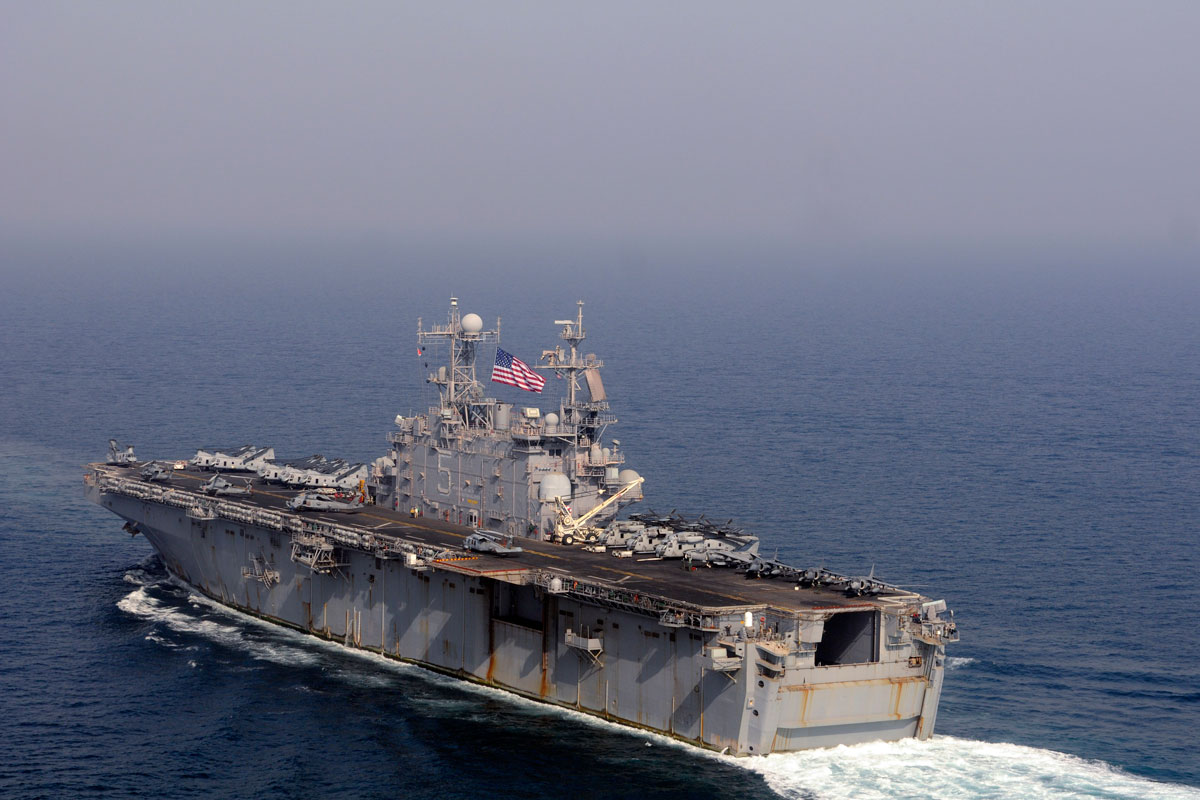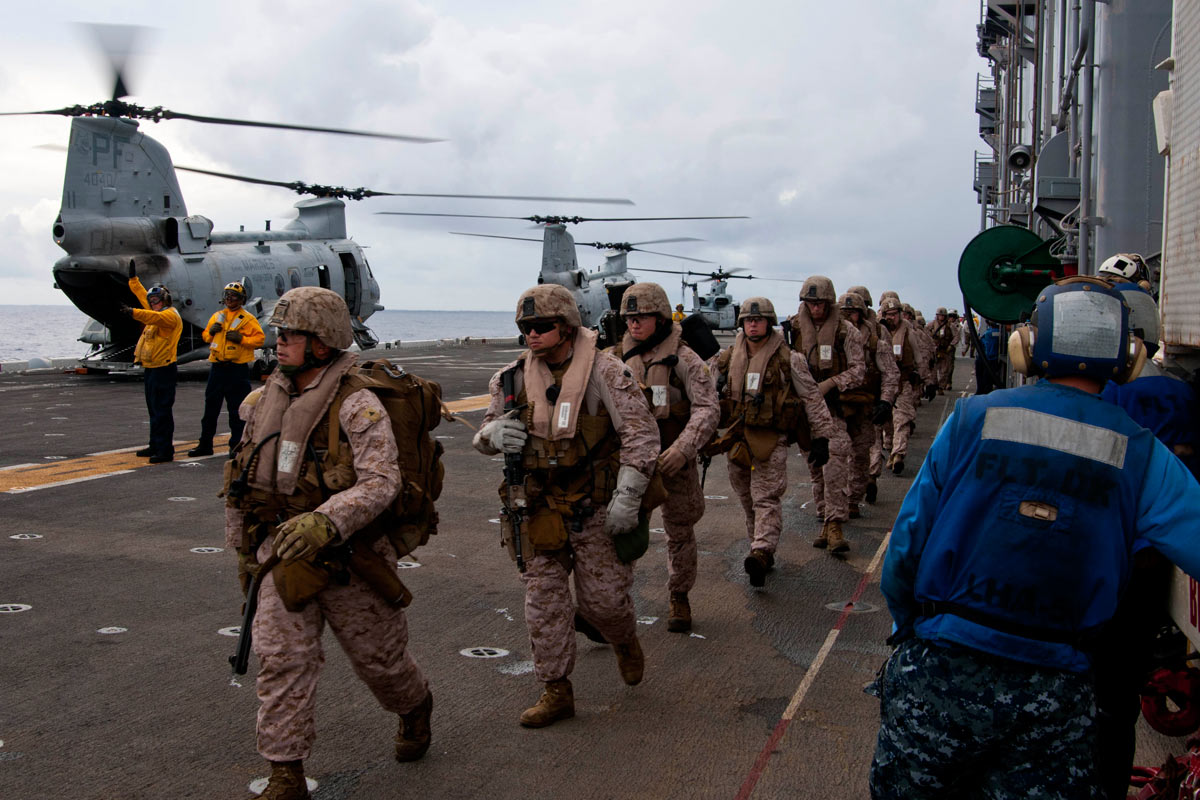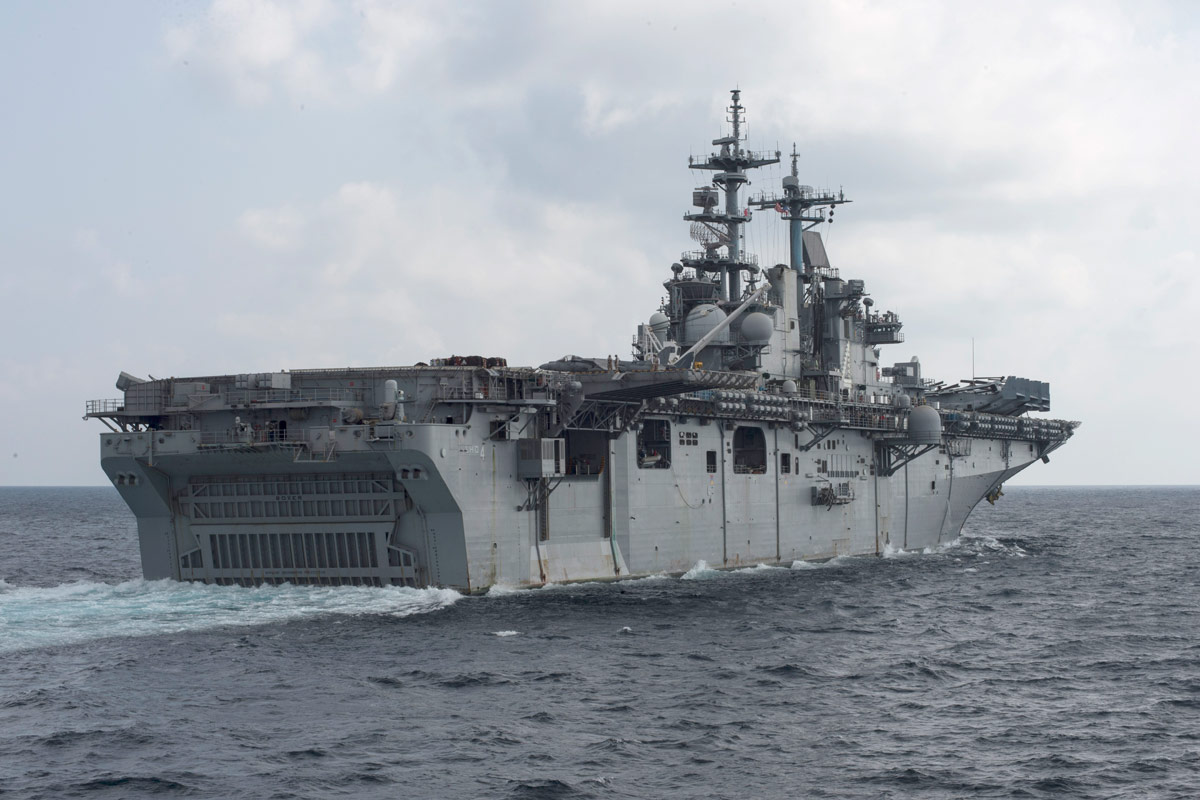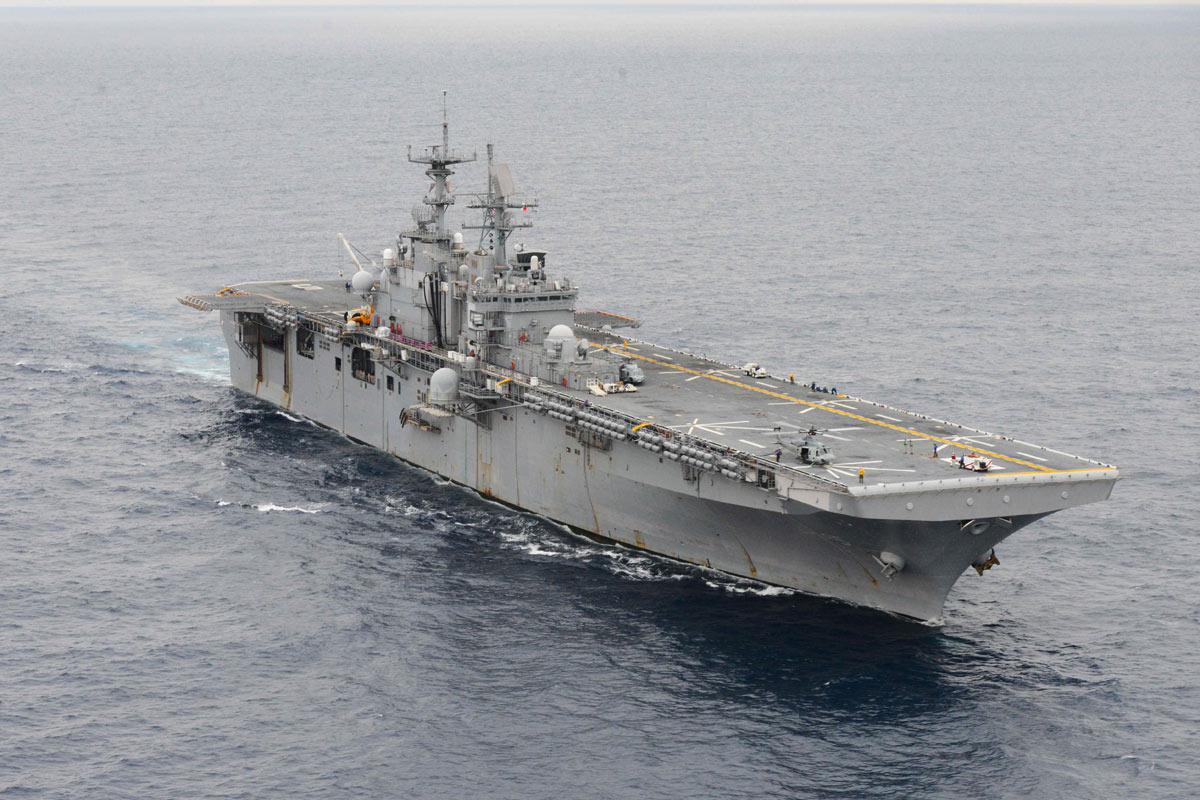Wasp Class:
Manufacturer: Ingalls Shipbuilding Service: USN, USMC Armament: 2x RAM launchers; 2x NATO Sea Sparrow launchers; 3x 20mm Phalanx CIWS mounts; 4x .50 cal. machine guns; 4x 25 mm Mk 38 machine guns (LHD 5-8 have three 25 mm Mk 38 machine guns) Propulsion: two boilers, two geared steam turbines, two shafts; two gas turbines, two Speed: 20+ knots Crew: 66 officers, 1,004 enlisted Marine Detachment: 1,687 troops (plus 184 surge). Aircraft: 12 CH-46 Sea Knight helicopters; 4 CH-53E Sea Stallion helicopters; 6 AV-8B Harrier attack aircraft; 3 UH-1N Huey helicopters; 4 AH-1W Super Cobra helicopters Landing/Attack Craft: 3 LCACs or 2 LCUs. Tarawa Class: Builder: Ingalls Shipbuilding Service: USN, USMC Armament: 2x RAM launchers; 2x Phalanx 20 mm CIWS mount; 3x .50 cal. machine guns; 4x 25 mm Mk 38 machine guns. Propulsion: Two boilers, two geared steam turbines, two shafts Speed: 24 knots Crew: 82 officers, 882 enlisted Marine Detachment 1,900 plus. Aircraft: 12 CH-46 Sea Knight helicopters; 4 CH-53E Sea Stallion helicopters; 6 AV-8B Harrier attack aircraft; 3 UH-1N Huey helicopters; 4 AH-1W Super Cobra helicopters. Landing/Attack Craft: 4 LCUs or 2 LCUs and 1 LCAC.Amphibious Assault Ships are the U.S. Navy’s largest of all amphibious warfare ships. They resemble a small aircraft carrier and are capable of operating with Vertical/Short Take-Off and Landing (V/STOL), Short Take-Off Vertical Landing (STOVL), Vertical Take-Off and Landing (VTOL) tilt-rotor and Rotary Wing (RW) aircraft. Amphibious Assault Ships contain a well deck to support use of Landing Craft, Air Cushioned (LCAC) and other watercraft (with exception of the first two LHA(R) class ships, LHA 6 and LHA 7, which have no well deck). LHA 8 will feature a well deck.
Modern U.S. Navy Amphibious Assault Ships project power and maintain presence by serving as the cornerstone of the Amphibious Readiness Group (ARG) / Expeditionary Strike Group (ESG). A key element of the Seapower 21 pillars of Sea Strike and Sea Basing, these ships transport and land elements of the Marine Expeditionary Unit (MEU) or Marine Expeditionary Brigade (MEB) with a combination of aircraft and landing craft.
The Tarawa-class LHAs and Wasp-class LHDs provide the Marine Corps with a means of ship-to-shore movement by helicopter in addition to movement by landing craft. Three LHAs -- which have extensive storage capacity and can accommodate Landing Craft Utility (LCU) and LCAC craft -- participated in Operations Desert Shield / Storm. Since that time, LHAs (and later LHDs) have been participants in major humanitarian-assistance, occupation and combat operations in which the United States has been involved.
Such operations have included participating as launch platforms for Marine Corps expeditionary forces into Afghanistan during Operation Enduring Freedom in 2001 and 2002, Iraq in Operation Iraqi Freedom in 2003 and humanitarian support after the catastrophic Tsunami in 2004. During Operation Iraqi Freedom, two LHDs served as “Harrier carriers,” launching an air group of AV-8B attack aircraft against targets inside Iraq. In 2004, LHAs and LHDs were used to transport thousands of Marines and their equipment to Iraq and Afghanistan for combat operations.
More recently, critical post Hurricane Katrina support was provided in New Orleans by LHD 7 (Iwo Jima) where thousands of police, fire and rescue personnel were hosted aboard during recovery operations and IWO JIMA operated as the central command and control hub. With delivery of Iwo Jima in 2001, the Navy and Marine Corps reached a desired force level of amphibious warfare ships -- LHAs/LHDs, LPDs and LSD 41/49s -- that provide fully capable Expeditionary Strike Groups to fulfill anticipated forward-presence and expeditionary requirements. The eighth LHD, Makin Island (LHD 8), was delivered to the Navy in April 2009, and commissioned in October 2009.
LHD 8 is the first U.S. Navy amphibious assault ship to employ gas turbines vice steam boilers, and the first Navy surface ship to be equipped with both gas turbines and an Auxiliary Propulsion System (APS). The APS uses two induction-type Auxiliary Propulsion Motors (APM) powered from the ship’s electrical grid instead of using main propulsion engines to power the ship’s shaft. Instead of using its gas turbines which are less efficient at lower speeds, the ship will be able to use its APS for roughly 75 percent of the time the ship is underway.
Over the course of Makin Island’s lifecycle, the Navy expects to see a fuel savings of more than $250 million. Because the gas turbines will be used infrequently, the Navy will also save on maintenance and lifecycle costs.
The entire propulsion and electric system is controlled by a comprehensive machinery control system that also controls and monitors damage control, ballasting and de-ballasting, fuel fill and auxiliary machinery. The machinery control system allows the ship to switch from gas turbine to electric propulsion on the fly. It is fully distributed, accessible from multiple locations, and every console provides full system control and monitoring capabilities of the entire engineering plant.
The propulsion plant and electrical distribution and auxiliary systems designed and built for Makin Island will also be used aboard the future USS America (LHA 6), the first ship in the LHA.
LHA 6 was placed under contract in June 2007 with NGSB, now Huntington Ingalls Industries (HII). LHA 6 will be an aviation-centric modified repeat of the LHD 8 and is scheduled for delivery to the Navy in 2013. Key differences between LHA 6 and the LHD class ships include an enlarged hangar deck, enhanced aviation maintenance facilities, increased aviation fuel capacity, additional aviation storerooms, removal of the well deck, and an electronically reconfigurable C4ISR suite.
Three of the original five Tarawa-class LHAs were recently decommissioned: USS Belleau Wood (LHA 3) in October 2005, USS Saipan (LHA 2) in April 2007 and USS Tarawa (LHA 1) in March 2009 and USS Nassau (LHA 4) in March 2011.
Amphibious warships are designed to support the Marine Corps tenets of Operational Maneuver From the Sea (OMFTS) and Ship to Objective Maneuver (STOM). They must be capable of sailing in harm’s way and enable rapid combat power buildup ashore in the face of opposition. Because of their inherent capabilities, these ships have been and will continue to be called upon to also support humanitarian and other contingency missions on short notice. The United States maintains the largest and most capable amphibious force in the world. The Wasp-class LHDs are currently the largest amphibious ships in the world. The lead ship, USS Wasp (LHD 1) was commissioned in July 1989 in Norfolk, Va. LHA Replacement or LHA(R) is the next step in the incremental development of the “Big Deck Amphib.” She is being designed to accommodate the Marine Corps’ future Air Combat Element (ACE) including F-35B Joint Strike Fighter (JSF) and MV-22 Osprey with additional aviation maintenance capability and increased fuel capacities, while also providing additional cargo stowage capacities and enabling a broader, more flexible Command and Control capability.
LHA 5 and LHDs 1-8 are in-service. LHA 6 (AMERICA) is planned for delivery to the Fleet in 2014. LHA 6 (AMERICA) was christened on Oct. 20, 2012. The Navy awarded a contract for detail design and construction for LHA 7 (TRIPOLI) to HII on May 31, 2012.
Ships in class (Wasp):
USS Wasp (LHD 1)
USS Essex (LHD 2)
USS Kearsarge (LHD 3)
USS Boxer (LHD 4)
USS Bataan (LHD 5)
USS Bonhomme Richard (LHD 6)
USS Iwo Jima (LHD 7)
USS Makin Island (LHD 8)
(Tarawa Class)
USS Peleliu (LHA 5)
